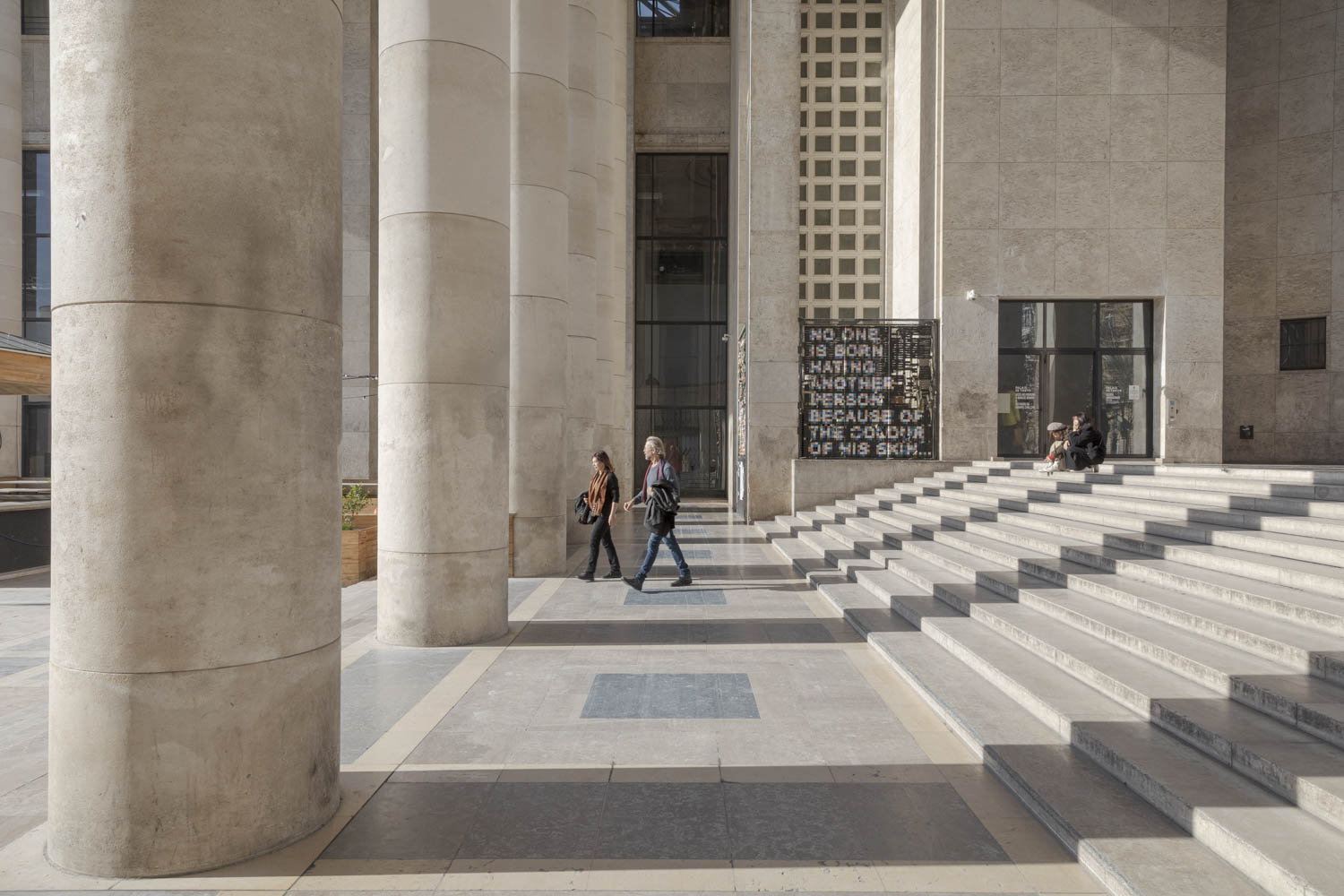
It would feel disingenuous not to admit that these past few years have instilled in me an acidic cynicism that, at times, is a relief to give in to. In the face of global illness, mass protests, ecological degradation, and war, cultural institutions have not found much inspiration to meaningfully change. What calls for decolonization and abolition have yielded from Western cultural institutions are gestures of inclusion, the ever-elegant parry against real transformation. Inclusion can take many forms: a race-focused cluster hire, a committee evaluating “urgent issues,” an exhibition highlighting the works of a marginalized group. The latter response tends to lean more toward collecting than collectives. With curators regurgitating the language of protest movements, an institution itself can move on from even the most radical programming without considering structural reevaluation. Even though such exhibitions are in dialogue with decolonial and abolitionist thought, the long-term impact of these temporary shows has largely been unremarkable.
Is it possible for an exhibition to fundamentally transform, upend, or even dissolve the institution that hosts it? This is the question I carried into two exhibitions about lands, waters, skies, fauna, flora, and the lives that human beings attempt to arrange upon, within, and among them. This past summer, I spent an afternoon in Paris touring the Palais de Tokyo’s Réclamer la terre and, later, spent several days in Montréal contemplating the Canadian Centre for Architecture’s ᐊᖏᕐᕋᒧᑦ / Ruovttu Guvlui / Vers chez soi / Towards Home.
Réclamer la terre (Reclaim the Earth), curated by Daria de Beauvais, featured fourteen artists and collectives from around the globe. It was open from spring to early September 2022. In a publication that accompanied the show, the museum’s new president, Guillaume Désanges, claims that the exhibition aimed to offer a response to intensifying ecological crises. Rather than returning “to former, so-called virtuous models” of human relations with the Earth, he writes, the show tried “to invent other types of relationships with our environments, based on what we have learned from anthropology, ethnology, and ecofeminism.”1 That said, many works in Réclamer la terre did investigate a return—not a return to the mythic image of pristine, unabused nature, but instead to knowledge of the Earth through its many systems and inhabitants, views that long predate what the Western academy has defined as “anthropology, ethnology, and ecofeminism.” Read in the context of the works it unites, the title of the show—Réclamer la terre—is less a rallying cry for ownership than one for recognition. These works invite the viewer to acknowledge the Earth as a family member with whom they have cut ties. Reclaiming means reestablishing that relationship, as punishing and awkward as the task may be.
The day I visited the Palais de Tokyo was one of the hottest days Paris had seen in nearly twenty years, a record that would be broken again by the following weekend. Not only did this render the city’s streets and buses practically uninhabitable, but it also closed down the opening rooms of Réclamer la terre, offering an unplanned affirmation of the exhibition’s urgency. As I approached the now-closed entrance, a museum guard quickly stepped over to me with concern on his face, redirecting me to the adjacent galleries. “Il fait chaud?” I inquired in my college French. The guard, his face lacquered in sweat and clutching a branded Palais de Tokyo fan, pulled the corners of his mouth down in exaggerated pain. “Madame, c’est très très très chaud.”
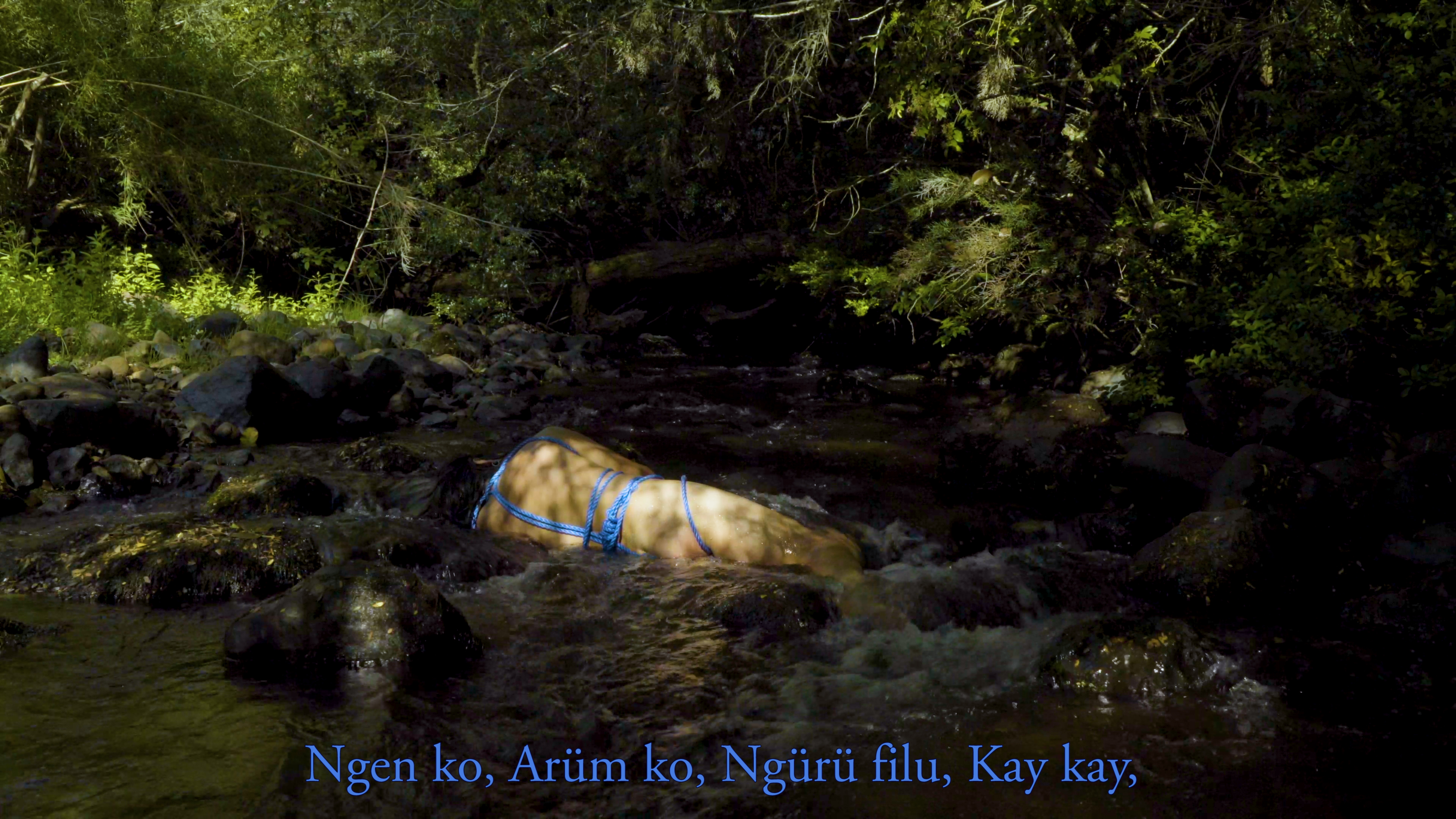
Inside the first room I entered, a small group of overheated museumgoers enviously watched Mapuche artist Sebastián Calfuqueo’s Kowkülen (Liquid Being) (2020). The film revolves around a nude figure wrapped in an intricate blue shibari-style rope harness that is alternately submerged within, washed away by, or suspended over a slow-moving river. In Mapudungun, the Mapuche language, the artist’s voiceover narrates a longing for greater intimacy with the water, imagining the human body, with its genders and rigidity, giving over to the form of a fish. In that stifled and dark little room, each of us shared the speaker’s longing. Short of a fish form, we would have gladly settled for a breeze. In some small way, the moment of communal perspiration also reiterated how crisis can motivate a desire for transformation.
The humid intimacy of Calfuqueo’s screening room opened onto one of the cavernous and clinically bright gallery spaces for which the Palais de Tokyo is known. While it featured paralyzed vegetation from Abbas Akhavan and towering sculptures from Huma Bhabha, it was Peruvian artist Daniela Ortiz’s understated miniatures that held the room’s magnetic point of focus. Featuring nearly fifty paintings, Ortiz’s series The Rebellion of the Roots (2020−ongoing) dominated one gallery wall, pulling the viewer’s focus down to the scale of her postcard-like depictions. These scenes alternated between plants nourishing Indigenous people, Indigenous people nourishing plants, and plants assassinating white colonizers, with rainbow-colored strokes highlighting the central action in each work. Ortiz’s paintings are strikingly minimal, bright, and cartoonish; they were also the most politically direct pieces in the entire exhibition. Each painting has a hand-drawn datum line of text with proclamations like “FEU AU COLONIALISME DU JARDIN D’ACCLIMATATION,”2 “Thank you strong anticolonial roots of the roiboos that grew to find the end to Belgian violent greed,” or “While making an official visit to the Royal Greenhouse of Laeken four coconuts will beautifully fall on top of the Belgian Minister of Interior whose life will be gone for not causing more suffering over migrant communities.” The paintings are hopeful and militant, unapologetic in their desire for both joyful life and vengeful death.
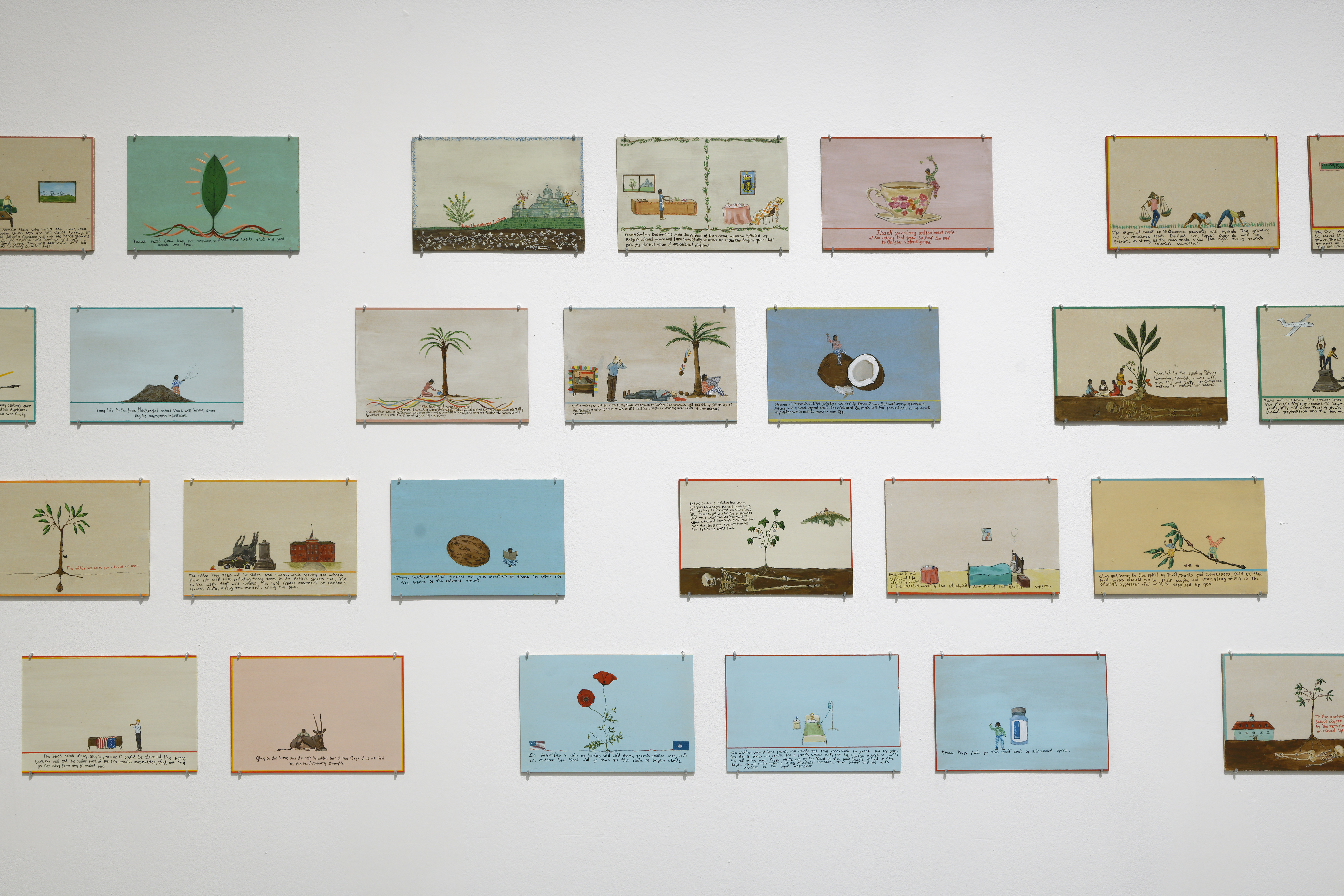
It was refreshing to see a piece like Ortiz’s that directly named and imagined the violence that other works were more tacitly responding to, which was why it was jarring to next descend to the Palais de Tokyo’s cool basement level, where French artist Laura Henno’s films were being screened in dialogue with the works of Réclamer la terre. Since 2013, Henno has been collecting footage in Mayotte, a small island department of France, off the coast of Madagascar. In one small room lined with pew-like benches, the film KOROPA (2016) was playing. It features tight close-ups of the strained face of a young boy named Patron, being trained by an older smuggler to navigate a small boat across the water between the islands of Anjouan and Mayotte. According to the wall text, because Patron’s youth exempts him from arrest under Mayotte’s anti-smuggling laws, he has become an attractive partner to older smugglers. The film made me deeply uncomfortable. It mercilessly tracks Patron’s resigned face as he receives instructions on how to handle the police. Unlike the closeness in Calfuqueo’s Kowkülen (Liquid Being), which gives the nude figure the privacy of anonymity, there was an untrustworthy intimacy to Henno’s movie. I felt implicated by the knowledge that this young person’s participation in a desperate trade was being exposed by a French filmmaker.
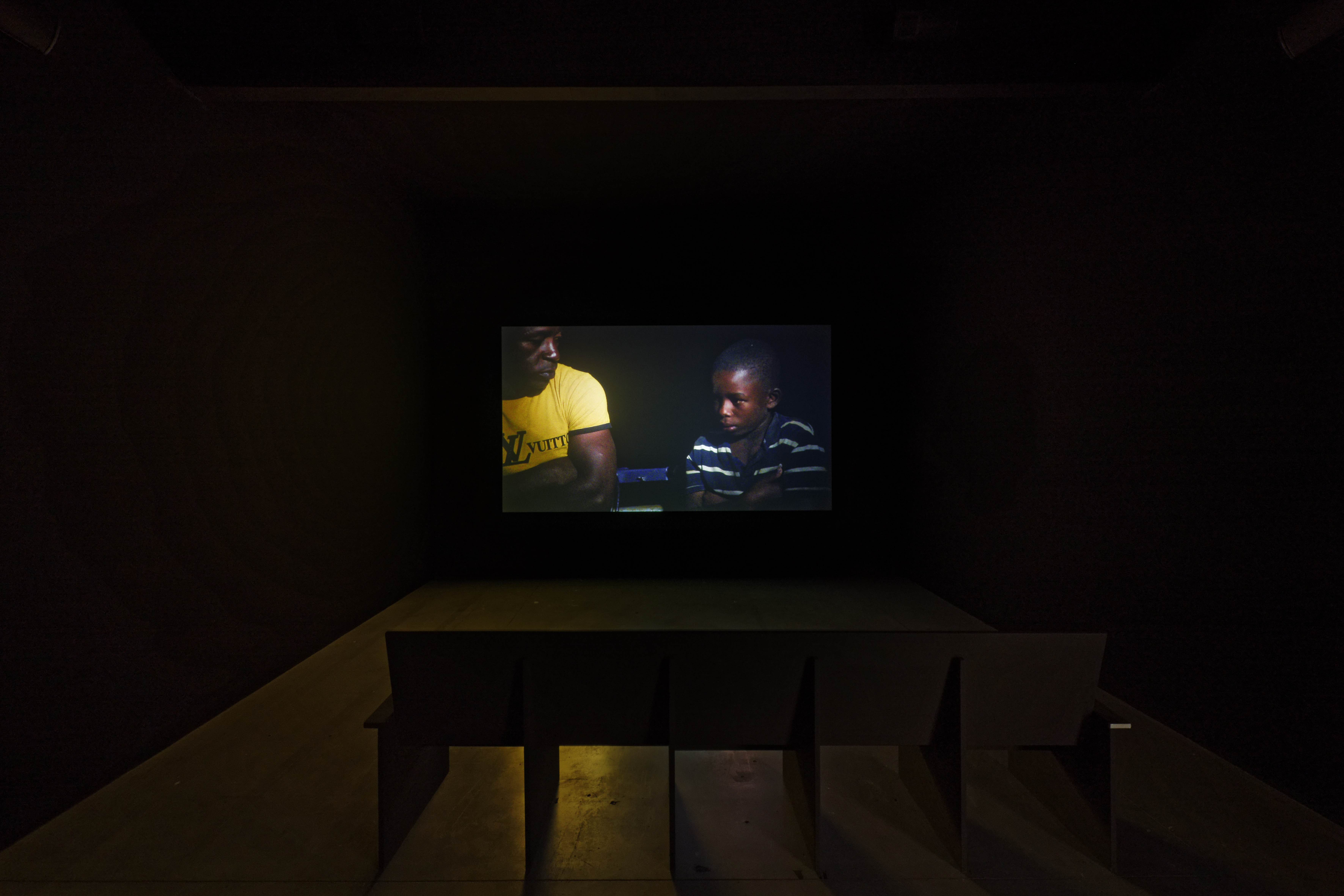
The wall text that accompanied KOROPA seemed to indict the actions of the older smuggler with little consideration of the instability that France’s continued presence in the region has contributed, or the potential consequences of Henno’s documentation. In the exhibition catalogue, Martiniquais essayist Patrick Chamoiseau breathlessly celebrates Henno’s methodology: “When Laura Henno approaches the people she bears witness to she does not merely gaze at them, she lives with them; she does not exhibit anything they might be, she reaches them. She does not take on the responsibility of crying for justice on their behalf, she inhabits them and lets herself be inhabited by them.”3 But Henno’s approach calls to mind a long line of ethnographic practices that are the provenance of France’s many colonial collections.
The violence of such practices was depicted directly in Ortiz’s work, located just one level above. This juxtaposition felt especially poignant in the Palais de Tokyo, which, young as it is, is still very much a member of the French patrimony and resides in the hull of an old world’s fair building.4 Henno’s apparent freedom to collect, consume, and expose Patron’s experience marked a jarring contrast to the thoughtful works in Réclamer la terre. Their inclusion side by side in both the museum and the catalog calls into question whether the institution’s desire to center marginalized knowledge and inquiry can be meaningfully pursued without relinquishing the remnants of colonial practices.
In Montréal, the Canadian Centre for Architecture’s (CCA) exhibition ᐊᖏᕐᕋᒧᑦ / Ruovttu Guvlui / Vers chez soi / Towards Home, which opened this June and closes next February, suggests the potential for a deeper institutional transformation. Rafico Ruiz, the associate director of research at the CCA, curated the exhibition along with Joar Nango, Taqralik Partridge, and Jocelyn Piirainen, each of whom belong to and organize cultural spaces in the northern Indigenous territories of Inuit Nunangat and Sápmi. Ruiz explained to me that, in his view, the exhibition does not try to solve or resolve anything; rather, it makes space for those who are often the subject of unwelcome observation to participate in their exposure and make demands in return.
At the CCA, all curatorial text for the exhibition was written in four languages: English and French, as required by law in Québec, and Inuktitut and Sámi. As with any act of translation, each member of the wall text quartet created an audience of its own, inevitably making subtle changes across the descriptions. The choice to include multiple translations is also notable in the context of Québec’s current politics. In May 2022, the province adopted Bill 96, expanding its mandate to center French as the primary language. The bill is currently undergoing legal contestation. Critics highlight that this legislation could make it difficult to access government services, including medical services, in any language other than French.5 In particular, the law threatens to disservice some Indigenous communities who do not learn or refuse to speak French—often for political reasons—as well as newly arrived immigrants. Against this backdrop of willful linguistic isolation, the CCA’s efforts, insisted on by the co-curators, are particularly poignant.
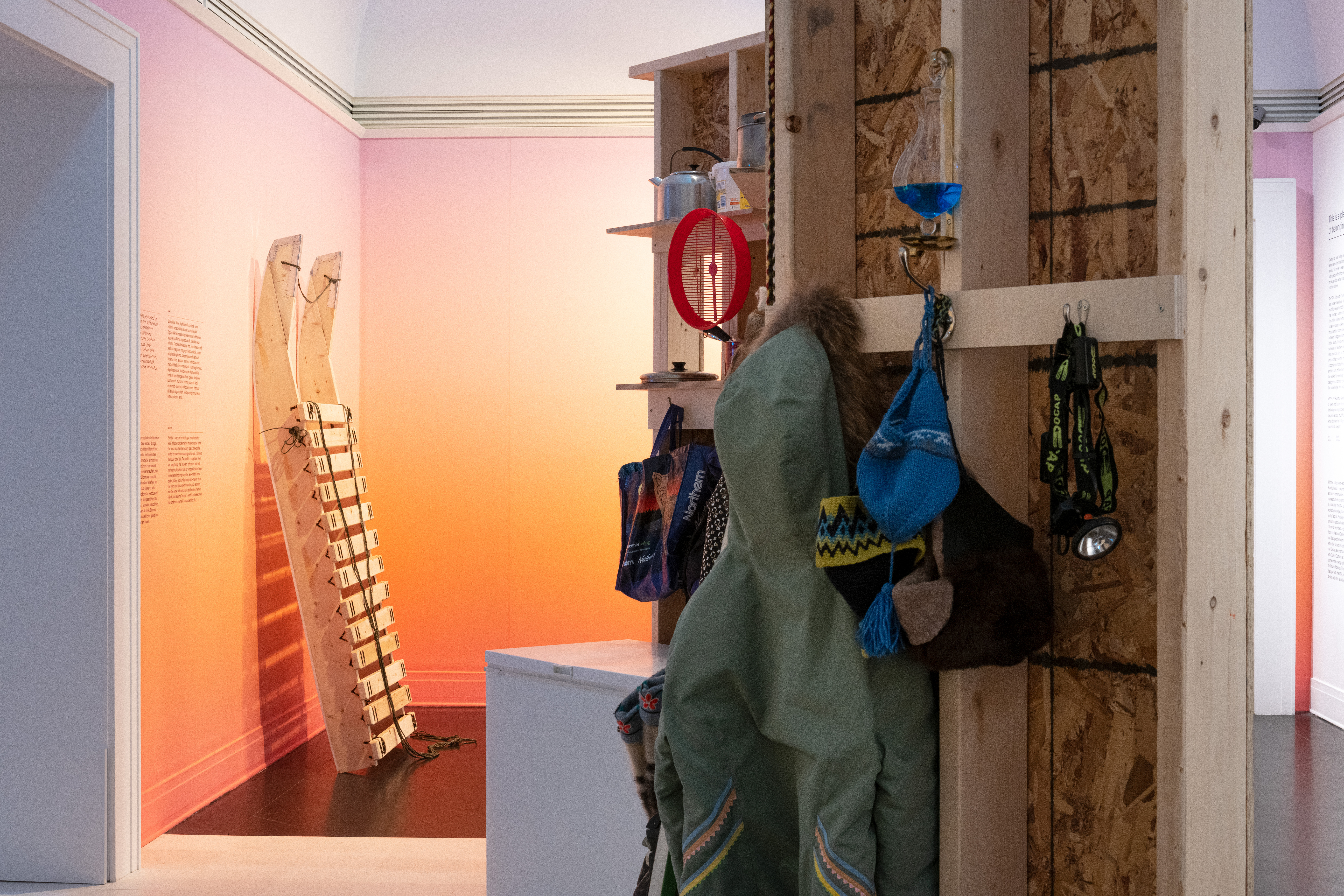
The entrance to ᐊᖏᕐᕋᒧᑦ / Ruovttu Guvlui / Vers chez soi / Towards Home includes a full-scale model of a typical cold-weather porch. Ruiz described this as a gesture of welcome to Inuit and Sámi visitors and an indication that the show would focus on Indigenous artists’ own contexts and references. The plywood porch, set in the museum’s main throughway, held all manner of household items that would usually be too wet, muddy, or frozen to be brought indoors, yet still need preservation from the outdoors. These articles, amassed by co-curators Partridge, Piirainen, and Nango, included a deep freezer, a fishing rod, braided grass used for stuffing shoes, skis, kamiit (Inuit sealskin boots), nuvttuhat (Sámi reindeer boots), and many other tools for living in the cold. They all hang in a pristine jumble, the objects devoid of the scuffs, stains, and watermarks that would reveal daily use.
In contrast to this conspicuous cleanliness, however, Ruiz told me that the porch items were not intended to be ethnographic but rather to suggest occupancy and life. This ambition runs through the CCA exhibition and evokes a certain tension, one also evident at the Palais de Tokyo exhibition. How can cultural institutions move beyond the typical limitations of a white-wall gallery space and toward different relationships with the objects on display? ᐊᖏᕐᕋᒧᑦ / Ruovttu Guvlui / Vers chez soi / Towards Home aims to swim against the long-held practice of Western cultural institutions that collect items from Inuit and Sámi households and display them as curiosities or trophies. The CCA took on these questions more directly by stepping back from its usual role and asking Partridge, Piirainen, and Nango to curate and define the space. Moving through the porch, three questions organized the rest of the exhibition: “Where is home?,” “Where do we go from here?,” and “Where does land begin?”
The first response came from Geronimo Inutiq, a multimedia artist originally from Iqaluit (once called Frobisher Bay, where the Nunavut Land Claims Agreement was signed in the 1980s). His piece consisted of three abstractions of domestic space: a tent, a wall of forest green Matchbox siding, and the white corner of a kitchen set. LED flat screens served as windows onto an icy landscape and a community radio program bubbled forth from a set on the kitchen table, filling the room. Inutiq himself scripted the audio program, titled Northern Virtual Broadcasting Channel One. It crackled with music, a weather report, warnings for children to stay off the ice, and tales of mythical qalupaliks who lie in wait under the water. The piece referenced the ever-present radios that connect the vast atomized region of the far North. The audio element animated the staged gallery spaces—I could hear it throughout the small exhibition—uniting them with a sense of use, as if an auntie had just left the kitchen to go outside for a smoke. Such small moments of domestic intimacy ran throughout the exhibition and challenged my sense of customary gallery etiquette. This was one way in which ᐊᖏᕐᕋᒧᑦ / Ruovttu Guvlui / Vers chez soi / Towards Home successfully distanced itself from the tropes of ethnographic display. Many of the exhibition’s environments maintained a sense of occupancy—even hospitality—that invited visitors to partake, pushing visitors to question their default carefulness in gallery spaces.
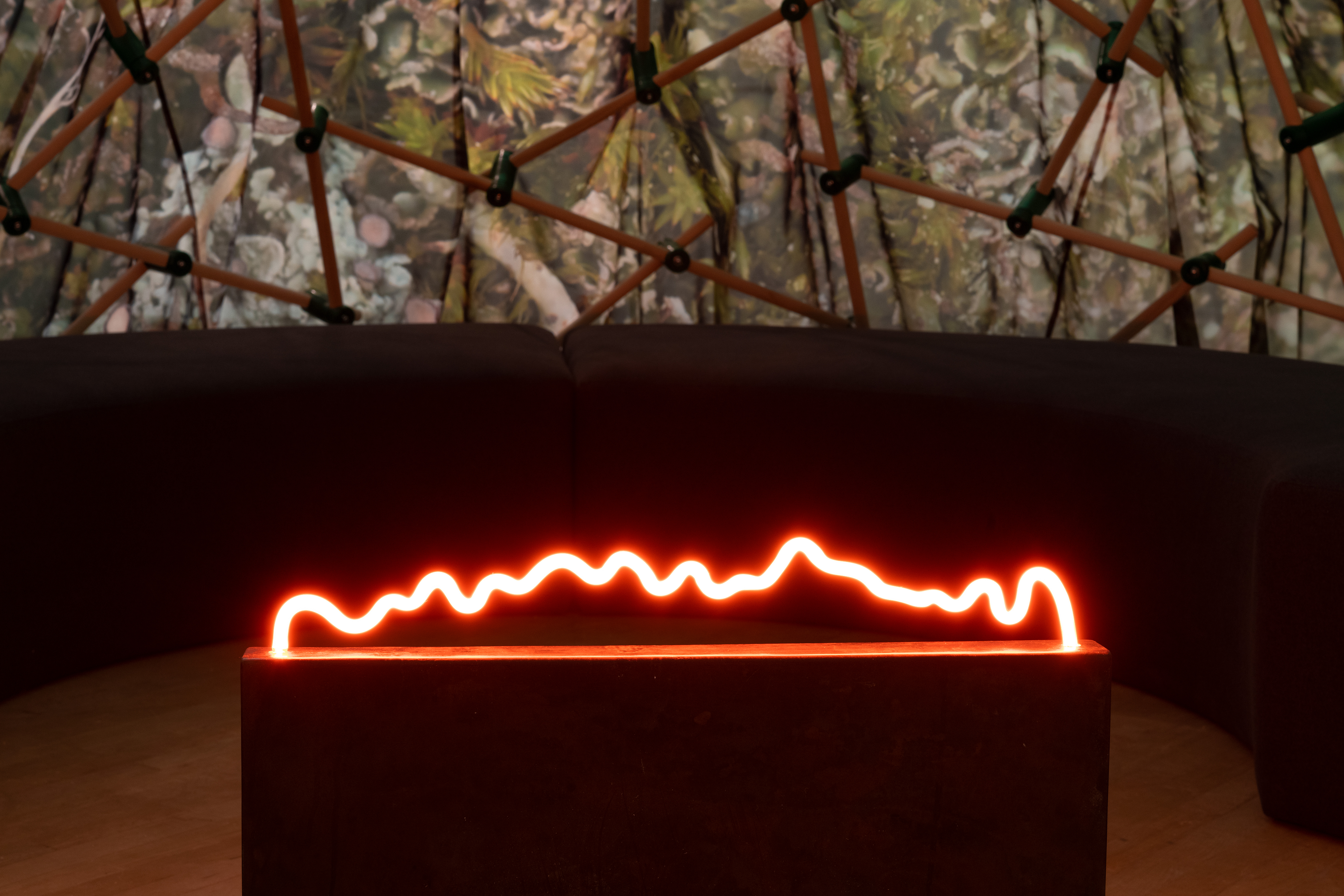
In the next room, the Canadian Inuk artist asinnajaq continued this theme in her piece Nuna (2022), a geodesic enclosure of maple dowels draped with printed fabric that houses a circular bench and neon qulliq (hearth). A few days after I saw the exhibition, asinnajaq told me over Zoom that Nuna had been inspired by one of the best outdoor naps of her life, when she slept nestled deep into a clutch of moss. asinnajaq also had work shown as part of Réclamer la terre. That film, Rock Piece (Ahuriri Edition)(2019), focuses on a pile of stones at the edge of a rough ocean. Over time the rocks shift, tumbling away to reveal a figure who turns, sleepy-eyed and tangle-haired, toward the camera. The stones then subsume the figure, and the viewer is again left with a pile of rocks. Both works express a sense of longing for a closeness with the Earth through an act of rest—a deep desire to embed oneself in land and be transformed in sleep.
When I visited the Palais de Tokyo, the screening room that held Rock Piece was inaccessible due to extreme heat; when we spoke, asinnajaq said that her summer had been dotted with apologetic emails from the museum, informing her of the space’s closure. I was only able to view it later, on my own screen, something that would have been impossible with her installation piece at the CCA. asinnajaq told me that she hoped I had lain down inside Nuna. But of course I hadn’t. Even alone in the gallery spaces, I instinctively performed as a good art-goer, though this decorum seemed at odds with the intentions of many of the artists. I felt reflexively cautious about what I should touch or sit on. Touring the show with Ruiz, I even defaulted to the role of a stern gallery guard, tapping the “Do not touch/Ne touchez pas” sign when he absently ran his hand over ponchos or carvings.

In the following room, I entered the first space dedicated to works from Sápmi, which also began the future-oriented “Where do we go from here?” section of the show. Unlike the other galleries, Carola Grahn and Ingemar Israelsson’s piece Offernat (Votive Night) (2022) is staged in darkness. In the midst of deep blue walls, low light, and an undulating neon tarp suggesting the northern lights, there sit two objects encapsulating a monthslong conversation between the artists on the future of Sápmi. Grahn and Israelsson speak of Sápmi’s landscape as being a loan from future generations. This extended dialogue was represented with two pieces: a drawing from Grahn and a carving from Israelsson. In abstract geometries and quick sketches of animals, Grahn’s drawing transcribed themes of gratitude and consumption. Israelsson—a practitioner of duodji, a Sámi craft tradition—contributed a bowl carved from a found birch burl fallen from an old tree. The liquid movement of birch grain wrapping the bowl’s generous curve left little doubt in the artist’s craft. But the bowl acted as not only an exemplar of skill but also a point of participation. Before entering the exhibition, visitors were offered dried flowers at the ticket counter and encouraged to leave them in Israelsson’s bowl if they were so moved. This I did do. The soft prompt for interaction harnessed gallery decorum to inspire stillness and reverence. It was a necessary quiet moment at the exhibition’s fulcrum: a welcome point of rest.
From this dark and calming space, the exhibition moves into a more vibrant register. In the bright Futurecasting room, I saw the work of nine northern Indigenous design and duodji students whom architectural designer Nicole Luke and CCA curatorial assistant Ella den Elzen had led in a series of workshops in Kautokeino, Sápmi. The room was bursting with as many ideas as a studio desk during final reviews, with each student’s work reflecting their often-displaced communities. Naomi Ratte’s Lost Natures stood out. An ash plank is incised with the waterways of Selkirk, Manitoba, and filled with meticulously coiled strings of tiny red glass beads that overshoot the wood and snake their way onto the plinth, reflecting the displacement of her Peguis First Nations people. In the piece, Ratte marries architectural modelmaking with precise craftwork to striking effect.
Unlike Réclamer la terre, there were no moments of confrontation in ᐊᖏᕐᕋᒧᑦ / Ruovttu Guvlui / Vers chez soi / Towards Home. The conflicts that Indigenous communities face due to a combination of climate change and government antagonism are only glancingly mentioned. For example, in the exhibition’s press materials, Ruiz described himself as a settler. Speaking with me about the show, he also mentioned the co-curators’ decision to avoid retelling traumas, opting instead for a future-focused view of craft, skill, and information exchange. Still, each work on view was informed by things not directly named. There was some discussion of what Inuit people continue to face under Canadian occupation in a video performance conversation by artist Laakkuluk Williamson Bathory, which addressed a kind of ongoing Disneyfication of Nunavut that ignores national conditions causing homelessness, addiction, and mental health struggles in Inuit communities. Yet, there was no work at the CCA like Daniela Ortiz’s paintings at the Palais de Tokyo; nothing that might overly disturb a visitor’s comfort. The CCA’s atmosphere resembled a workshop, processing a density of information and questioning its next steps.
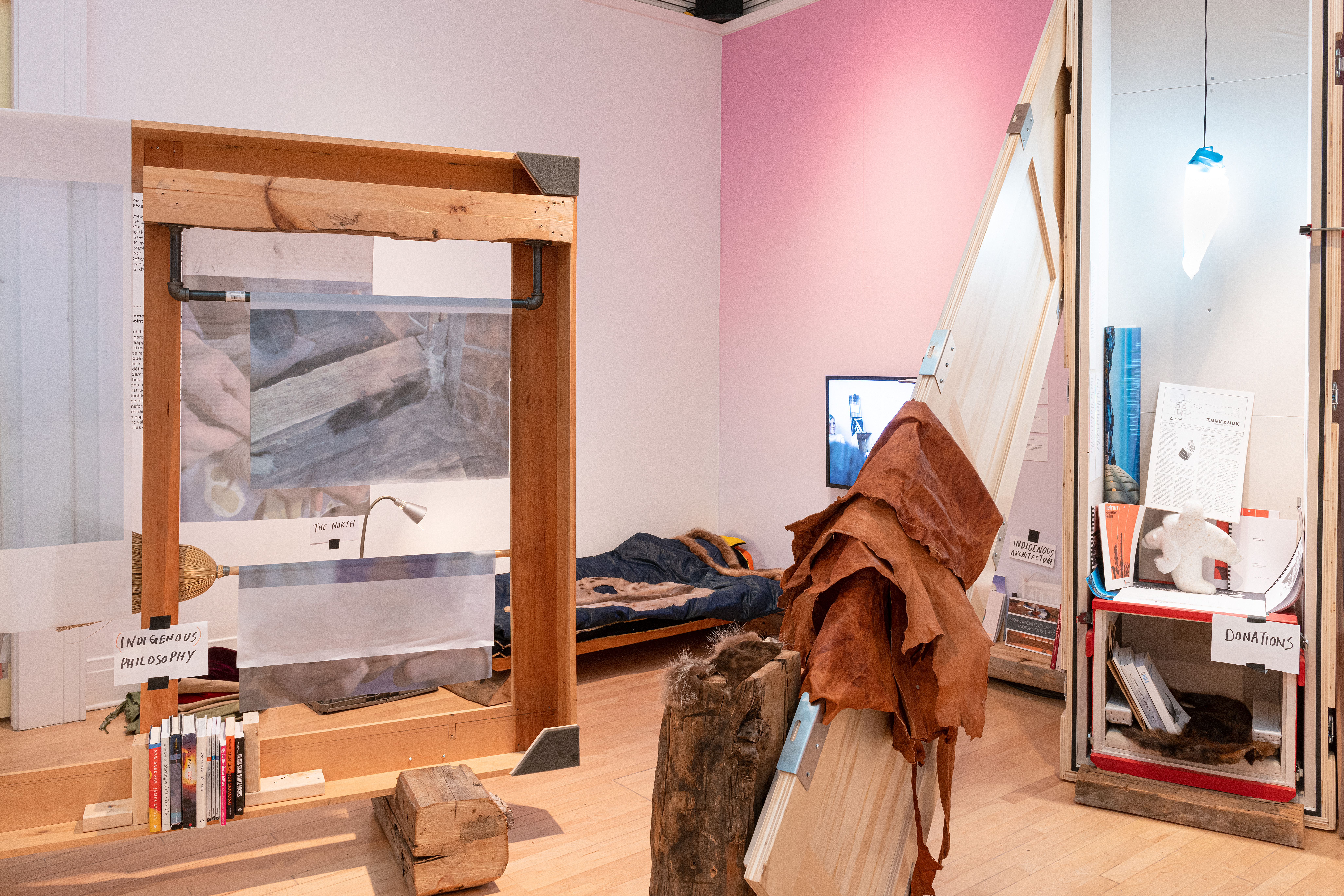
The last room was Sámi architect Joar Nango’s Girjegumpi (Sámi Architecture Library)(2018–), a portmanteau of the Sámi words for “book” and “mobile cabin.” The piece was first shown in 2018 at the Arctic Arts Festival and has seen many iterations since. This version of Girjegumpi was an arrangement of books, screens, lamps, coolers, furs, benches, fabrics, headphones, drawings, and much more, all displayed on the wooden crates they were shipped in. There was a mad discursive enthusiasm about the room. In the same way Inutiq’s auntie may have just wandered out for a smoke, the studious denizens of Girjegumpi may return at any moment and hold forth on the space’s many books and video lectures. The piece was also awash in audio from Inutiq’s Northern Virtual Broadcasting Channel One and Williamson Bathory’s recorded conversation—these sounds pooled into Nango’s library, hinting at lively conversation.
That simultaneous, discursive cacophony might describe the CCA itself: hosting conversations and fostering relationships that seem to expand endlessly. ᐊᖏᕐᕋᒧᑦ / Ruovttu Guvlui / Vers chez soi / Towards Home is rife with strings left loose. In addition to Nuna, asinnajaq also curated Tillitarniit at the CCA, a performance festival she started at Concordia University. The Futurecasting students returned to the CCA in October 2022 to hold a final workshop. The catalog for the exhibition is not yet published, although much of the writing is complete, as it is still being adjusted according to debates on language, co-publishers, and narrative balance. These iterative processes require time, resources, and loosened expectations. They require an institution to open itself.
Given this, I can understand the appeal of a more traditional approach, like Réclamer la terre, which offered a definitive statement in place of an unfinished conversation. With a massive space that spread its exhibition over two levels, the Palais de Tokyo had enough room to give each artist space to breathe—a conventional individual gallery presence. But from the show itself to its polished magazine, it seemed clear that once Réclamer la terre closed, it was complete. Its impact on the goings-on of the Palais de Tokyo will likely be unremarkable. By contrast, the six pinched rooms of ᐊᖏᕐᕋᒧᑦ / Ruovttu Guvlui / Vers chez soi / Towards Home are dense with unresolved work, intention, and purpose that require conversation in order to unpack them. At the end of this small show, I found myself in need of Girjegumpi’s benches and chairs. Any of the rooms could hold its own as an exhibition.
Performance artist Ange Loft, while not featured in the exhibition, is currently the first Indigenous-led Design Fellow at the CCA. Her engagement with the CCA still has an air of ambiguity to it, and exemplifies this conversational, unresolved approach. She is hosting a series of salons with other Indigenous researchers that will touch on her multiyear project on human remains and urban archaeology in Montréal. “The CCA wants something clean and final,” she told me, “but my work is meant to be revisited. It’s messy on purpose.” She was already thinking of who would be the next fellow and how they might pick up where she leaves off. Loft’s works engage a time scale difficult to contain in one fellowship; some of her projects can stretch for ten years or more. She wondered aloud whether the CCA had the time and resources to continue to follow topics that meander without easy resolution, sometimes endlessly, cyclically repeating. Then Loft shrugged her shoulders, half smiled, and said, simply, “We’ll see.”
The CCA’s unfolding, relational commitments could be called rhizomatic, a mycological adjective du jour that carries the weight of progressive hopes for human−nonhuman relations. In the end, people hold different sets of responsibilities than do our fungal neighbors, however metaphorically or literally we are related. People run into obstacles that require negotiation, agreement, concession, conflict, and often a bit of humor to resolve. While Réclamer la terre hosted excellent artworks that proposed (and in some cases threatened) returns and changes to our relationship with the land, there was no sense that the museum itself would rise to any of those provocations after the exhibition closed. The works were spaciously included in the museum’s outsized galleries, but even as extreme heat overtook those rooms, a true commitment to decolonial ways of working is unlikely to take hold at the Palais de Tokyo. The CCA’s ᐊᖏᕐᕋᒧᑦ / Ruovttu Guvlui / Vers chez soi / Towards Home, by contrast, evokes a collective desire for continued, open-ended interactions. The show and its museum retain a self-conscious uncertainty of whose terms and whose turf might be able to sustain such relations going forward. The possibility for meaningful impact is there; whether it will take root remains to be seen.
-
Guillaume Désanges, “Editorial,” Palais 33 (2022): 3. ↩
-
“Fire to the Jardin d’acclimatation*’s colonialism.” The Jardin d’acclimatation is a children’s amusement park in the Bois de Boulogne, located on the western edge of Paris. At the turn of the twentieth century, the park also hosted a human zoo, with human beings brought from French colonies to be exhibited as examples of the country’s imperial exploits. ↩
-
Patrick Chamoiseau, “Laura Henno L’Instance du Devenir / The Instance of Becoming,” Palais 33 (2022):47. ↩
-
The 1937 Exposition Internationale, to be precise. ↩
-
CBC/Radio Canada, “Now That Quebec’s New Language Law Has Been Adopted, Many Wonder How It Will Be Enforced,” June 1, 2022, link. ↩
Jess Myers is an assistant professor of architecture at Rhode Island School for Design. Her practice as an urbanist includes work as an editor, writer, podcaster, and curator. Her podcast Here There Be Dragons takes an in-depth look at the impact of security narratives on urban planning through the eyes of city residents.

